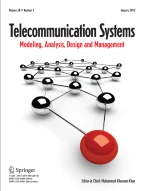Abstract
Methods are developed to estimate the source–destination traffic distribution matrix of a packet network using only aggregate link and source/sink traffic measurements. The methods are useful for network planning and monitoring of large packet networks, where it is impractical to gather measurement data on every end-to-end traffic flow. The first method assumes that the distribution matrix is time-invariant. This method is of theoretical interest but provides the foundation for developing a method for the realistic case of a time-varying matrix. The second method assumes that the matrix is time-varying. It uses linear programming (LP) to find a distribution matrix that optimally fits the measurement data. A practical problem with the first two methods is that the computational requirements increase as the square of the number of network nodes. The third method is a fast exact decomposition procedure for the time-invariant case that scales with the network size. The maximum number of unknowns that needs to be solved simultaneously is equal to the number of network nodes. The final method is a fast decomposition procedure for the time-varying case. This procedure scales with the network size. It uses LP to find an approximate distribution matrix that optimally fits the measurement data. The methods are applied to simulated example networks to illustrate the accuracy and speed.
Similar content being viewed by others
Explore related subjects
Discover the latest articles, news and stories from top researchers in related subjects.References
A.W. Dunstan, A mathematical model of telephone traffic dispersion in some Australian Metropolitan Networks, Australian Telecommunication Research 11(1) (1977) 84-91.
N. Kim, A point-to-point traffic estimation from trunk-group and office measurements for large networks, in: Proc. of the 13th Internat. Teletraffic Congress, eds. A. Jensen and V.B. Iversen (North-Holland, Amsterdam, 1991) pp. 465-469.
P.S. Min, M.V. Hegde and A. Rayes, Estimation of exogeneous traffic based on link measurements in circuit-cwitched networks, IEEE Transactions on Communications 43(8) (1995) 2381-2390.
J.P. Moreland, Estimation of point-to-point telephone traffic, The Bell System Technical Journal 57(8) (1978) 2847-2863.
B. Noble and J.W. Daniel, Applied Linear Algebra (Prentice-Hall, Englewood Cliffs, NJ, 1977).
M.M. Syslo, N. Deo and J.S. Kowalik, Discrete Optimization Algorithms (Prentice-Hall, Englewood Cliffs, NJ, 1983).
M. Tu, Estimation of point-to-point traffic demand in the public switched telephone network, IEEE Transactions on Communications 42(2-4) (1994) 840-845.
Author information
Authors and Affiliations
Rights and permissions
About this article
Cite this article
Conway, A.E., Li, M. Estimating the Traffic Distribution Matrix of a Packet-Switched Network Using Aggregate Traffic Measurements. Telecommunication Systems 24, 9–28 (2003). https://doi.org/10.1023/A:1025891325140
Issue Date:
DOI: https://doi.org/10.1023/A:1025891325140
